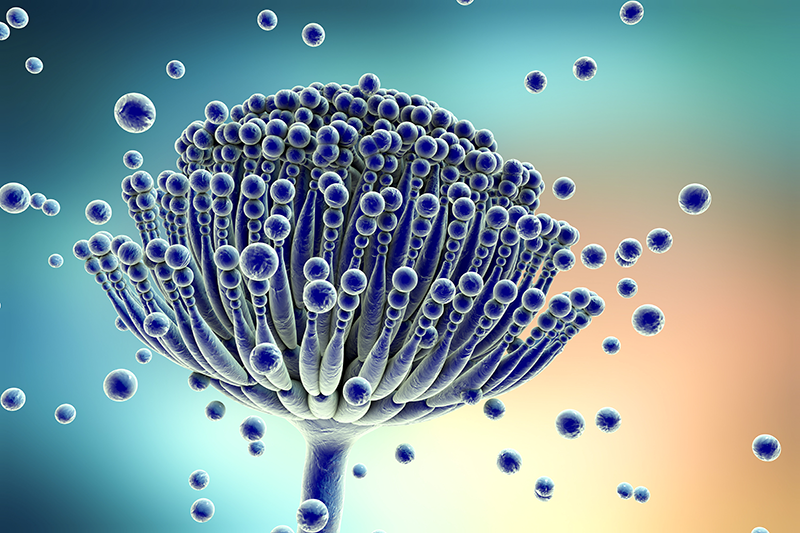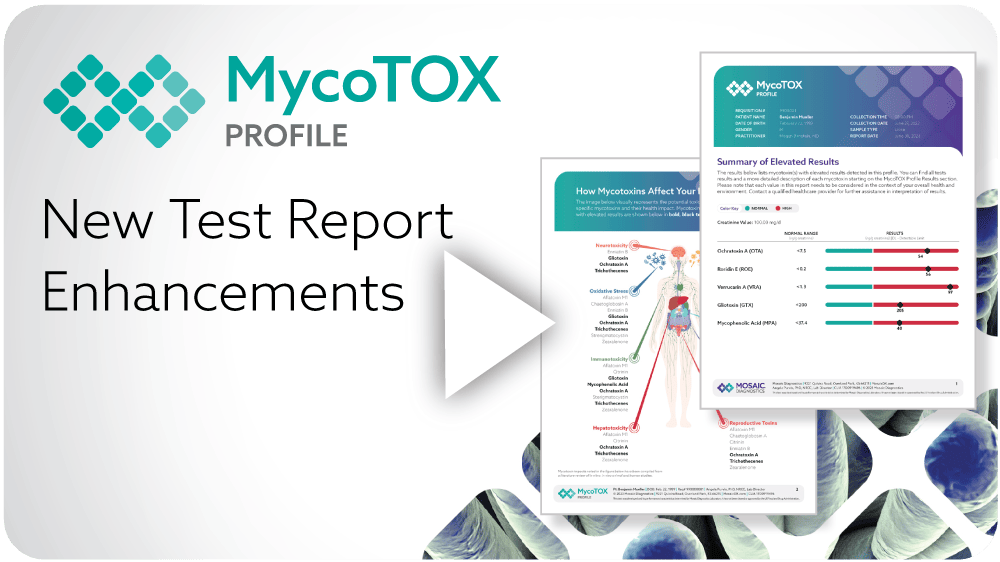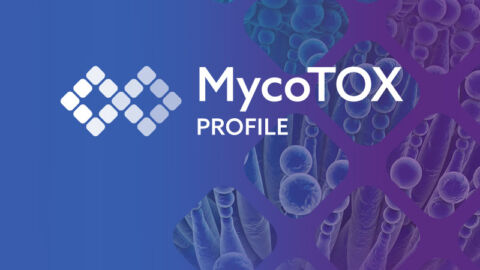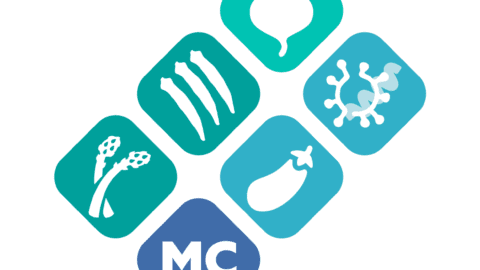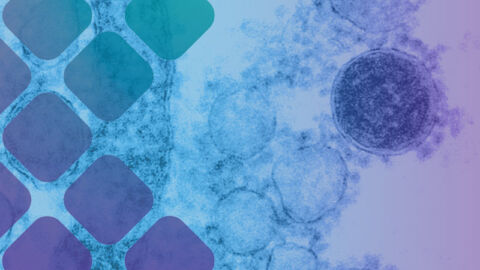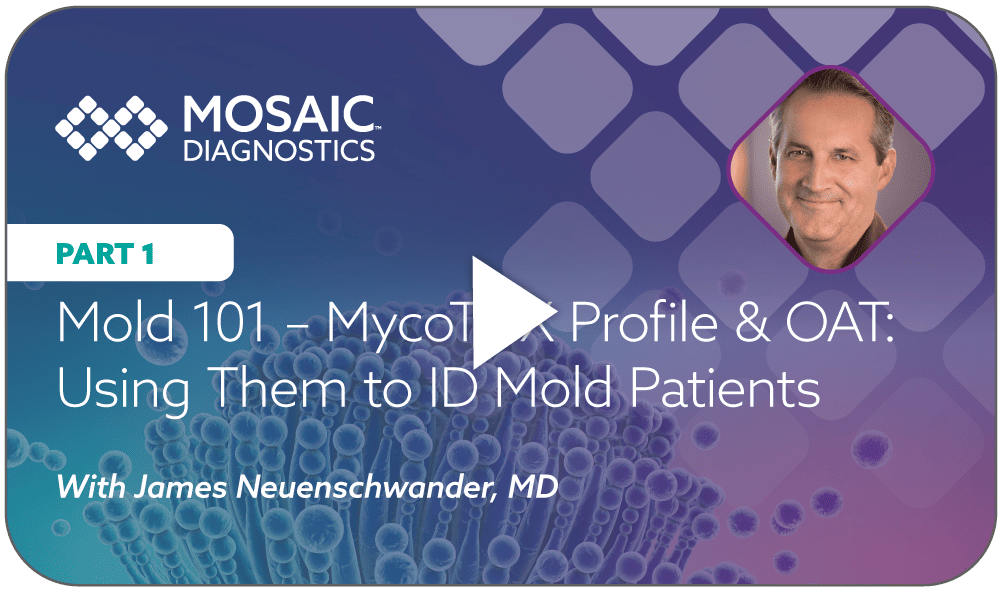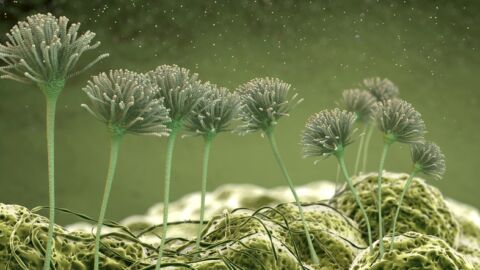Details
Why Test for Mycotoxins?
Mycotoxins cause adverse health effects that may be acute and chronic in nature that can manifest in various and ambiguous symptoms, the degree of impact can vary depending on the age, sex, genetics, and underlying health status of the exposed individual, as well as the duration and dose magnitude of the offending substance and their synergistic effects with other mycotoxins. Providers assessing symptomatic patients with known mold exposure or with an environmental history concerning mold exposure, will also need to consider the concomitant presence of mycotoxins and their potential negative health impacts as proper testing is essential for accurate treatment. The MycoTOX Profile is specifically designed to help healthcare practitioners identify mycotoxin exposure and guide a targeted prevention and treatment plan.
How Can Someone Be Exposed to Mycotoxins?
Common routes of exposure include inhalation, dermal contact, and ingestion via commonly contaminated food sources (corn, cereals, ground and tree nuts, spices, dried fruits, apples, coffee, meat, milk, and eggs). Mold contamination can also affect nearly all indoor materials, including drywall, paint, wallpaper, carpeting, and more, posing various routes of exposure. When excessive moisture is present in high-humidity geographic areas or water-damaged buildings, the growth of these biological agents in damp environments leads to the production of spores, cells, fragments, and volatile organic compounds, which have been linked to a wide range of health hazards.
How Does the MycoTOX Profile Measure Mycotoxins?
The MycoTOX profile utilizes state-of-the-art liquid chromatography tandem mass spectrometry (LC-MS/MS) technology to ensure high specificity (or fewer false positive results) and capture free (unconjugated) mycotoxin presence even at low levels. This is crucial, as mycotoxins, even at low levels of exposure, can cause serious health problems. Our test is so sensitive that we can detect amounts of many compounds in parts per trillion (ppt). To account for variations in fluid intake, we utilize creatinine correction to ensure accurate and reliable results. By employing LC-MS/MS technology, we can precisely identify all our analytes, reducing the risk of false positives. With the MycoTOX Profile, you can trust that you are receiving the most accurate and reliable results possible.
Learn More About the MycoTOX Profile: Explore FAQs
Analytes
The MycoTOX Profile urine-based assay assesses levels of 11 different mycotoxins.
Below is a list of all all analytes included in the test along with a brief description.
An aflatoxin of concern, AFM1, is a hydroxylated metabolite of AFB1 and is secreted in the milk of both humans and animals.
Ochratoxin A (OTA) which is the most prevalent, toxic, and clinically relevant fungal toxin of this mycotoxin group. While it has been associated with numerous negative health impacts, the kidney has been noted to be its main target organ – and studies indicate its association with nephrotoxicity in humans and animals.
Tricothecenes are extremely potent inhibitors of protein synthesis and have been described to have wide-ranging negative systemic effects including immunotoxicity (immunosuppression), gastrointestinal toxicity, neurotoxicity, and dermatologic manifestations.
The main toxic effect of Zearalenone relates to its endocrine disruptive capabilities and as such, resultant negative reproductive effects in humans and animals.
Chaetomium globosum is frequently isolated from materials found in water-damaged buildings – and is often referred to as ‘black mold.’
ENB has been shown to have endocrine disrupting properties as well as the ability to cross the blood brain barrier in in vitro assays.
Airborne Aspergillus fungal spores are ubiquitous in many environments making potential exposure to gliotoxin common. Gliotoxins have been found on linoleum flooring and wallpaper in water damaged buildings, as well as silage and other animal food stocks.
MPA is used as an immunosuppressive drug for the prevention of transplant rejection in the form of sodium mycophenolate (Myfortic™, Novartis) and a pro-drug, mycophenolate mofetil (CellCept™, Roche) – and as a result, its levels may be elevated on diagnostics in patients using these pharmaceuticals.
Sterigmatocystin is a precursor of aflatoxin B1 in fungi capable of producing aflatoxins. Despite the similarity of chemical structure of these two mycotoxins, Sterigmatocystin has been noted to be a less potent carcinogen than Aflatoxin B1 (AFB1). It is classified as a Group 2B carcinogen by the International Agency for Research on Cancer.
Exposure to CTN has been linked to the development of nephropathy, which is caused by CTN’s ability to increase the permeability of mitochondrial membranes in the kidneys. Rat studies have demonstrated that CTN is carcinogenic. Furthermore, several studies have linked exposure to CTN with a suppression of the immune response.
Sample Reports
The MycoTOX Profile test report is designed to provide you with easy-to-interpret results and comprehensive insights into your patients’ health.
Key Features on the Report Include:
- Summary of Elevated Results: Identifying potential health concerns becomes even easier as the new report prominently highlights mycotoxins with high results. This streamlined analysis process ensures you can focus on what truly matters.
- Human Figure Graphic: Enhance your patient communication with a human figure graphic that intuitively illustrates mycotoxins and their health impact. Your patients will appreciate this visual aid, making complex information more accessible.
- Source Chart: Easily navigate mycotoxins and sources, emphasizing potential toxicity and a comprehensive view of mold species.
- Improved Readability: Results are categorized by mycotoxin class for convenient referencing, enhanced by a visually intuitive chart.
- Comprehensive Test Results: The enhanced report will provide you with a complete list of test results, offering a holistic view of your patients’ mycotoxin profile. This comprehensive overview is the cornerstone of thorough analysis and comprehensive treatment planning.
- Detailed Interpretations: Empower your decision-making process with in-depth information for each mycotoxin. This includes insights into sources of exposure and potential health impacts. Armed with this knowledge, you’ll have the confidence to guide informed treatment choices.
Test Prep and Instructions
MosaicDX offers patient-friendly sample collection kits that simplify testing. Our kits include visual, step-by-step instructions for test preparation and sample collection, personalized shipping cards, and pediatric collection bags if needed. With MosaicDX, patients can easily collect samples for testing with confidence and accuracy.
Patient Resources
Assets for practitioners to support patients in understanding mycotoxins and MosaicDX’s MycoTOX Profile, enhancing their patients’ comprehension, decision-making, and overall health journey.

